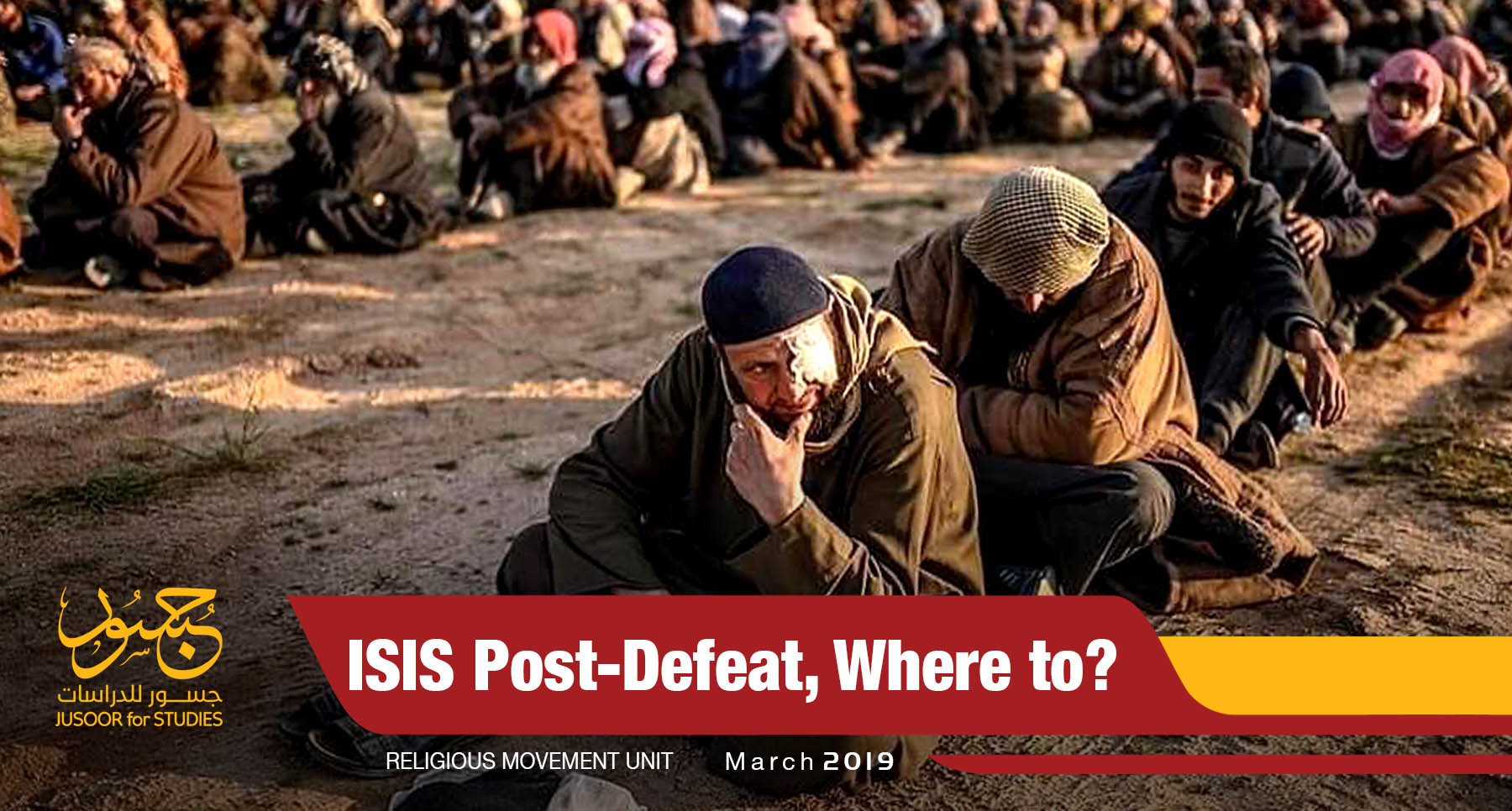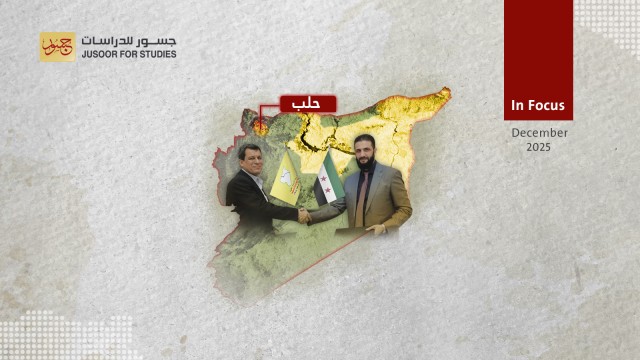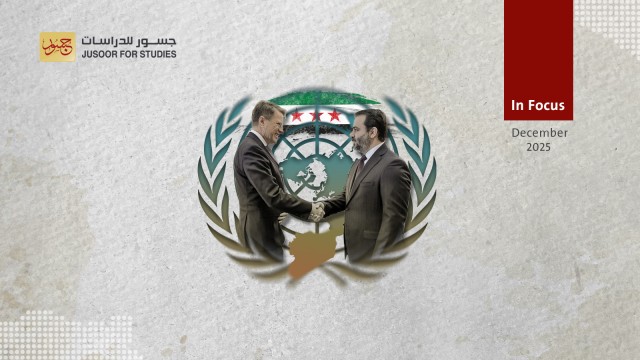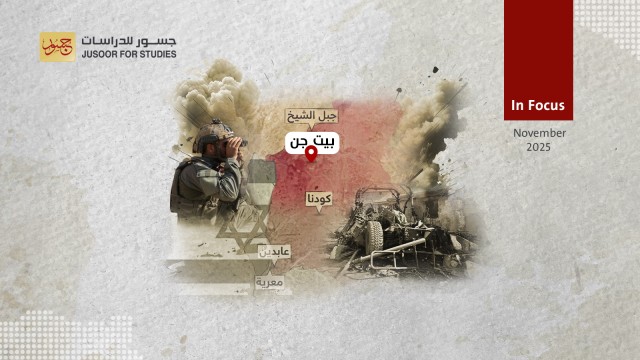ISIS Post-Defeat, Where to?
Font Size
First: Introduction and Prelude
The rise of the Islamic State in Iraq and the Levant (ISIS) was not coincidental but its ascent lasted for almost a decade amid an accumulation of consequential events. Abu Musab al-Zarqawi's declaration about the of establishment of the Tawhid and Jihad group in Mesopotamia was the actual starting point for the formation of ISIS. The formation developed with al-Zawqawi pledging allegiance to Osama bin Laden and the formation’s merger with al-Qaeda in Mesopotamia, which soon turned into the Islamic State of Iraq. The Islamic State of Iraq suffered heavy losses in 2008-2009 until it was reduced to sleeper cells spread throughout the Anbar desert.
The organization took advantage of the events of the Syrian revolution to alter the political reality by announcing the establishment of the Islamic State in Syria and Iraq under the command of Abu Bakr al-Baghdadi, the supposed new caliph for Muslims. Al-Baghdadi called on Muslims to migrate to the organization controlled lands in the provinces of Iraq and Syria and pledge allegiance to him as the legitimate representative of Islam and Muslims. These events marked the start of the organization’s expansion phase and its fight against various other organizations such as al-Qaeda, Ahrar al-Sham and the Free Army factions.
Second: Traces of ISIS’s Appearance and its Collapse in the Fight Declared Against it
ISIS managed to spread its control over vast areas of Iraq and Syria inhabited by around eight million people. It possessed sufficient oil and human resources to threaten the cohesion of neighboring countries, causing several regional and international countries to form an alliance left by the United States of America (USA) to face ISIS which, at that point in time, had started launching attacks on the environs of Kobani - Ain al-Arab.
The rapid rise of ISIS raised various questions about its capabilities, components and the extent of its strategic and organizational complexity. Its hast to break borders and declare the caliphate were the direct cause of the destruction of local and military civil society links and the establishment of networks with new links. This destruction prompted politicians, religious figures and social elites to intensify their efforts to understand the organization and how to deal with it. In addition, thousands of fighters of different nationality had joined ISIS and ISIS’s military operations spread along a wide front stretching from Mosul to the city of Manbij west of the Euphrates River. ISIS withdrew amid the International Coalition’s continuous pounding against it with ground support from the Syrian Democratic Forces (SDF). Despite ISIS’s large losses and the massive material and human costs it suffered, the attacking forces were unable, in most of the battles and regardless of their superior capabilities, to liberate ISIS controlled cities except after almost totally destroying those cities. By destroying ISIS controlled cities, the International Coalition were eventually able to extract ISIS from its most important strongholds in Syria and Iraq, and confine ISIS elements within a limited geographical area in the Syrian Badiya (desert) in the ‘framework’ of a hidden presence that does not represent any kind of control. The remaining ISIS forces present in the Badiya are living temporarily in “security holes” to avoid being killed or captured as they wait for a deal that saves them from the inevitable fate with the complete absence of the ISIS commander with continuous talk of his escape and disappearance.
The rise of ISIS increased sectarian tensions in Syria and Iraq. These tensions existed prior to its appearance due to the central state’s policies, its excessive production of extreme violence and the absence of deterrents in its unprecedented employment and exportation of violence. Due to ISIS’s policies and all these factors, it was possible to create sharp chasms within “Islam”. The Takfir crisis deepened because ISIS used it as a weapon against the society as a whole and against its opponents in the jihadist formations that agree with ISIS in the Salafist ideological principals in its “imaginary Wahabi” representation; therefore, the weight of the crisis Muslims are currently experiencing due to the rise of ISIS will not disappear followings it collapse.
Third: Local and International Contexts
The rise of ISIS confused local and international forces’ political calculations as its expansion represented a blatant challenge for the state and international system logic. The failure of local forces (represented by the revolutionary factions - the old system) in facing ISIS, led to various international forces moving to intervene directly in Syria under the cover of multiple pretexts. Regime allies expressed their intervention as based on fighting and confronting ISIS. Russia, for instance, claimed that Washington was not “fighting it with the seriousness required”. On the other hand, America found in ISIS’s appearance a direct means to return militarily to the region and it led a broad international alliance to counter ISIS and destroy its growing power.
The emergence of ISIS has been a direct cause for the shift in the national security priorities of some countries which resulted in a sharp divergence in positions among these countries as well as conflicting and at times intertwining interests. These results are based on different visions of how to deal with ISIS. The Turkish-American difference was based on each side’s vision of the dimensions and central issue of the conflict in Syria, where Turkey insisted on the need to fight ISIS as part of a comprehensive approach that deals with the origin and root of the problem – i.e. Bashar al-Assad regime and its sectarian and destructive policies. The Obama administration did not respond to this issue and even contradictorily reinforced Turkey’s fears through its broad support for “separatist” factions which it adopted as a partner in the war against ISIS in Syria. In addition, the distance between Turkey and the USA was further increased by the indirect coordination between Iran and the USA in Iraq despite Iran’s exclusion from the International Coalition.
It is noteworthy, that Obama prioritized reaching an agreement with Iran regarding its nuclear file, so the negotiation and reaching an understanding with Iran was given priority over ending the Syrian regime’s crimes, satisfying Turkey or using a comprehensive approach to deal with the ISIS. Accordingly, it is possible to explain Washington approaching the Kurdish People’s Protection Units; however, it is important to highlight that these alliances and positions are governed by specific declared goals, the most important of them being the elimination of ISIS. Following this, subsequent shifts and breakdowns in alliances are expected considering firstly the interests of the target set and secondly the stage of the operation. These reinforce the American withdrawal proposal in parallel with the long and complex ongoing discussions to establish a safe zone in northern Syria which a key Turkish demand.
Fourth: ISIS Scenarios After the Field Defeat
ISIS’s appearance was the result of a shift in the structure of the contemporary terrorist system. Therefore, ISIS’s loss and its isolation following the field defeat has fundamental repercussions on the future condition of ISIS. From this premise, it is necessary to highlight a point that should not be ignored in dealing with “Islamic State” phenomenon which is the “ideology that it built for itself”. The state presented itself through intensive propaganda, supported by extraordinary expert visuals, as reflecting an imagined and absented Islamic identity simultaneously. The organization is the supposed representative of Sunni Islam that is threatened with extinction by the ‘state’, organizations and multiple sects, and ISIS’s battles were based on this principle. Thus, ISIS’s danger does not stem, in its entirety, from it being an extremist organization, but rather from it representing an ideological expansionist ideology at a time of widespread setbacks and break downs. This supposed identity constituted grounds prompting two types of people to support the organization. The first were its members and those who associated with them, regardless of whether the fighter is alive or dead, including their families, wives and children. With the passage of time, ISIS became a “society” where objectives and ideology are compatible and associated with applied theory. Therefore, ISIS’s decline in the field does not mean that its society, a host for extremism especially among children seeking revenge for their fathers and women who have lost their sons and husbands, will disappear. The second type of people are broad segments of un-ideologized youth in the world who rush to support or sympathize with ISIS based on their agreement with it regarding its efforts to restore the marginalized Sunni identity and its practical embodiment of an “Islam” state after the last such state ended over one hundred years ago. Eliminating the state’s authority on the ground does not signal the end of the ideology it created and exported to a large number of people in its areas of control and around the world. Therefore, ISIS thought will continue to exist through its cells, ideas and sympathizers’ support for the cause of this marginalized identity despite its loss of ground in the field.
The post-ISIS scenarios are restricted considering two options from which multiple possibilities stem. The first option: the revival of the state and its rise once again, while the second option is represented in the unravelling of the state’s contract entirely and its practical end. There are increasing questions relating to ISIS’s future between the possibility of its revival in the form of the caliphate, its complete termination or its turn to other strategies.
a. Reorganization and Advancement Once Again
Within the following option are these possibilities:
1. Rehabilitation of the jihadist network framed by the “hard core” of the ISIS leadership in the field in Syria and Iraq, tasked with restructuring the departments and directorates concerned with developing field and tactical strategies. The state’s path indicates the reinforcement of this possibility as it has been following this model since its inception and across all its transformations. ISIS has pursued this from the time of its establishment to it becoming the Tawhid and Jihad faction, then in its merger with al-Qaeda and pledging allegiance. It continued to pursue this following the announce of its transformation into the “Islamic State in Iraq" and the Sahwa fighting it to the point of almost eliminating it, whereby it was in a state similar to ISIS today, except that the organization disappeared in the Anbar desert, changed its targeting tactics, spread once again taking advantage of the political situation created by the revolutions whereby it emerged once again as the Islamic State in Iraq and the Levant seeking to restore the caliph using the power of arms and jihad. The complex transformations over time reveal the nature of dealing with the situation, and since ISIS’s position today is similar to its position after its battles with the Sahwa forces in 2008-2009, the organization will tend towards hiding in difficult natural terrain in the desert of Iraq and the Syrian Badiya. It is also likely to carry out continuous assassinations and multiple bombings through its network of sleeper cells or by drafting new ideological recruits. In addition, ISIS may rely on guerrilla warfare as this method does not necessitate being grounded in particular locations with the aim of holding on to and defending the location. Alongside this method, ISIS will implement the strategy of “individual wolves” who work within narrow spaces with the aim of harming the largest number of people to simultaneously put pressure and exact revenge on the targeted country that either fought against ISIS or facilitated the war against it. This strategy is fueled by ISIS jihadists’ movement to new lands which means the movement of its ideology and violent methods to these places. Naturally, these may occur in parallel with the attempts of the “ISIS cubs”, trained in ISIS land and who grew up on its ideology, to create a new generation of jihadists while trying to avoid the “field tactics” errors committed by ISIS and which resulted in its defeat in the field.
2. The organization’s movement to new positions within the strategy of geographical distribution in several “states” and building local networks in these new states to transition to the stage of the state once again. This would be achieved through the organizational groups and structures subordinate to it supervised by al-Baghdadi or through trusted agents in regional countries such as Saudi Arabia, Egypt, Algeria, Sudan, Afghanistan and other countries that ISIS can exploit their domestic and political situation to redeploy in them. This possibility is strengthened by the organization possessing the “funds” needed for such a move. Previously during ISIS’s administration of the land it controlled in Syria and Iraq, ISIS obtained hundreds of millions of US Dollars that it stored in secret locations. According to some media sources, ISIS transferred large sums of money to several regions in countries such as Iraq, Afghanistan, North Sinai and Libya. It is also possible that ISIS invested in electronic currencies, which are difficult to follow or freeze. ISIS is able to generate funds through the smuggling of arms and oil on the black market. Also by working with some tribal sheikhs who benefited from dealing with the organization during the period of its control as part of operations to smuggle oil and goods and individuals.
In an announcement in early 2018, al-Baghdadi called on his supporters to go to the land of the new Caliphate in Afghanistan, suggesting that there is an alternative plan for the organization to be transferred to Afghanistan in the event of losing ground in Iraq and Syria. However, the situation on the ground in Afghanistan and the field and organizational forces of the Talban in Afghanistan will be a strong barrier for the organization to move there.
3. A coup against the current leadership in the organization and the transition to another leadership which manages the process of rehabilitation and resurrection. The aim would be to present ISIS as being different to the other jihadist organizations highlighting their lack of suitable for the establishment of the state of Islam and raising the banner of jihad. This distinction will be an essential point for the leadership of the global jihadist organization and it depends on the extent the powerful factions within the organization achieve this aim. As for example the violent al-Hazemi current known for its extremism and Takfiri tendencies, where this current can turn the situation upside down, especially as the leaders of this current are influential on the Shura council and the military judiciary within the organization. However, al-Baghdadi had moved to remove them by arrest or liquidation in some cases. At this time, the presence of branches supporting this current in the organization structure will generate support for the legitimacy of their leadership and for the reannouncement of the Caliphate considering the great chasm currently being witnessed. This possibility is reinforced by the absence of Abu Bakr al-Baghdadi from the leadership scene for a long time which negatively impacts the organization and which may result in accelerating the divisions between his supporters and opponents.
4. In the context of the organization’s supposed return, it is suggested that the organization will return as an “Iraqi organization” with a global discourse due to being forced to rebuild its network in Iraq, rather than any other places, as Iraq has witnessed its first seed, the subsequent expansion of its power, its collapse before the Sahwa’s strikes and its launching a strategic move towards Syria in order to achieve strategic gains including funds, oil, weapons, military and human capabilities, etc. Despite destroying the “organization’s military control”, the reasons for its return to Iraq are present as there is a continued “Sunni incubator” that still suffers from the same grievances that resulted in the formation of the organization previously. In addition, the social networks that supported the organization in the past are still present now but with a more painful and severely impacted reality. As long as the contexts that resulted in the emergence of the organization do not change, the organization’s reasons to return to the Iraqi field will continue to exist.
B. Termination and Unravelling the Organization:
At the outset of presenting this scenario, it is necessary to indicate the weakness of its occurrence in practice. The organization’s younger members are in fact the second generation of contemporary jihad which started in Iraq and strengthened with al-Qaeda’s movement there, and then the move to the state stage while the “Caliphates Cubs” and the sons “of the organization’s killed and captured” represent the third generation. Therefore, the possibility of their abandoning the Caliphate ideology is near impossible whereas the issue of jihad continuing through them is a process that is mentally and logically more probable.
In the context of the termination and unravelling of the organization, the possibilities are limited. The most prominent is the separation of its leadership and influential blocs in its military factions from it entirely and their transition to a new organizational formation. This case depends on the existence of popular incubators in Syria and Iraq which suffered from the choice of the “organization’s absolute control” for two considerations, one is related to the nature of the motivation of popular support for the organization in Iraq. Despite the continued injustices experienced, except the pains suffered during the period of ISIS absolute control will form a barrier for supporting the reformation of a network using its previous name or another name. The second reason relates to the nature of the organization itself which Syrians reject as the organization is located in popular consciousness as the main reasons for the regime’s re-entrenchment, the spread of its control once again due to the organization’s violent and radical fight against the revolutionary factions opposing the regime. These factors confirm that although ISIS is absent or defeated temporarily, its return in a different form or under new names is possible but cannot be assumed. The Sunni incubator and local communities have realized the reality and fate of such organizations, and it is not easy to accept such an idea and tool again in order to “repel injustice”.
It is possible to indicate the other options that members of the organization may pursue in limited numbers as “individuals” or “cells”. These individuals or cells may join local jihadist organizations or join al-Qaeda considering it the original uterus from which ISIS emerged. Alternatively, they may completely abandon the jihadist cause and working to achieve the Islamic State which would lead, in the end, to the complete dissolution of the organization and the unravelling of its influential structure.
Fifth: Conclusion
In over, almost, a decade and a half, jihadist manifestations accumulated whereby ISIS represented an extensive experience in benefitting from reality and practically turning it to its advantage or at least mitigating its harmful effects. ISIS changed organizationally, it successfully exploited and benefitted from the field reality with the start of armed action in the Syrian revolution. It added to the “international” jihadist work after embodying the “Islamic” state and declaring the sought-after caliphate and then expanded at the expense of other organizations.
This rapid rise has raised various questions about ISIS’s capabilities and components, its role in destroying previously existing social ties and its quest to establish networks with new ties. In addition, ISIS’s intense influence in creating sharp divisions within the structure of Islamic thought by deepening the “Takfir” crisis and using it as a smoking gun in the face of “the "other/objector”. ISIS’s rise also changed local and international forces’ political calculations as its appearance was the direct cause of modification in the national security priorities of countries. The shift resulted in a sharp divergence of positions among key actor states based on different visions on how to deal with the organization. The organization gave rise to a map of alliances and positions governed by specific and declared goals, the most important of which is the elimination of ISIS. Subsequently, the map of these alliances changed and some of the alliances unraveled which was expected considering the interest in the outlined target first and the stage of the operation second. As such, the American proposal to withdraw is reinforced and comes in parallel with ongoing long and complex discussions regarding a proposal to establish a safe area in northern Syria as demanded by Turkey.
Certainly, ISIS’s present defeat in the field will prompt the emergence of fundamental implications in its future condition. In this context, it is necessary to highlight points that should not be ignored in dealing with the “Islamic state” phenomenon, namely the “ideology that the organization built”. Through intensive propaganda, supported by extraordinary professional visuals, ISIS presented itself as simultaneously expressing an imagined and absented Islamic identity. Therefore, ISIS will make choices or pursue scenarios “predominantly” based on this ideology that it established about itself. These scenarios are, almost, limited to two possibilities:
The first necessitates “reorganizing the organization’s structure and rising once again”. Within this first scenario there are three expectations: 1) Rehabilitation of the jihadist network framed by the “hard core” of the organization leadership in Iraq and Syria or through 2) The organization’s movement to new positions in several states within the geographical area distribution strategy and building local networks in them to move to the state stage once again with organizational groups supervised by al-Baghdadi himself or through trusted agents in some regional countries. 3) A coup against the current leadership in the organization and moving to another leadership where this expectation is dependent on the ability of strong branches within the organization to achieve this such as the violent al-Hazemi current which is known for its extremism and its tendency to “Takfir”. Previously, al-Baghdadi worked to exclude them from the organization leadership through arrest and liquidation at times. 4) The return of the organization to Iraq and globalizing its discourse by using the idea of repelling injustice to try to rebuild the clusters and networks supporting it.
As for the second scenario, it is represented in “breaking the organizational contract and terminating it in practice” through the separation of its leaders and influential blocs and their forming a new military organization or by them joining local organizations or al-Qaeda from which ISIS originally emerged. The other alternative, is that members abandon the cause of jihad and work to achieve the state of Islam, which, in the end, leads to dissolution of the organization completely and the violation of its influential structure. However, the reality indicates the weakness of this scenario being realized considering the available conditions.








